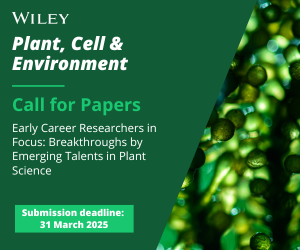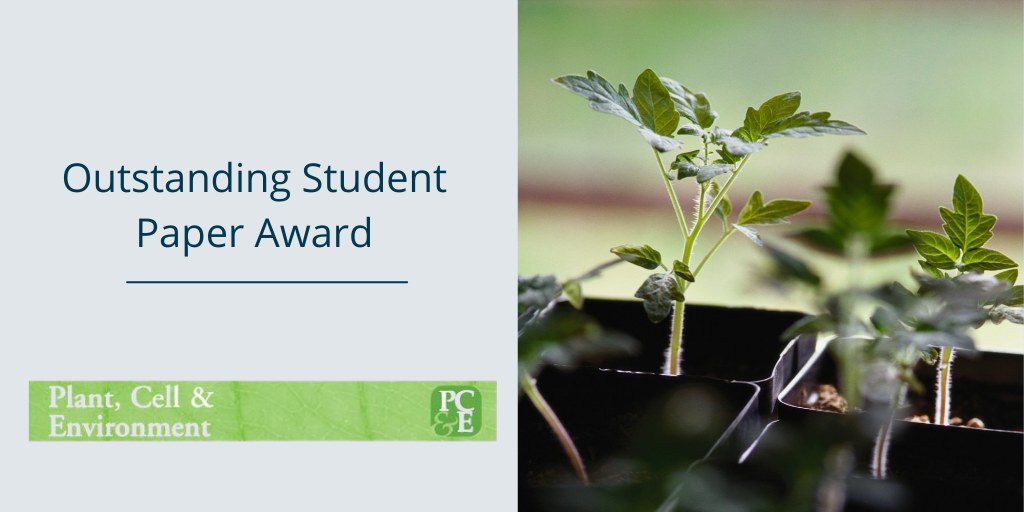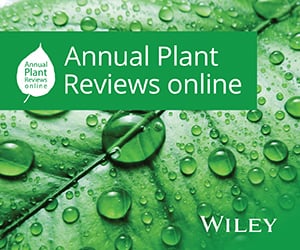Journal list menu
Export Citations
Download PDFs
COVER IMAGE
Front Cover Image
- Page: i
- First Published: 07 June 2023
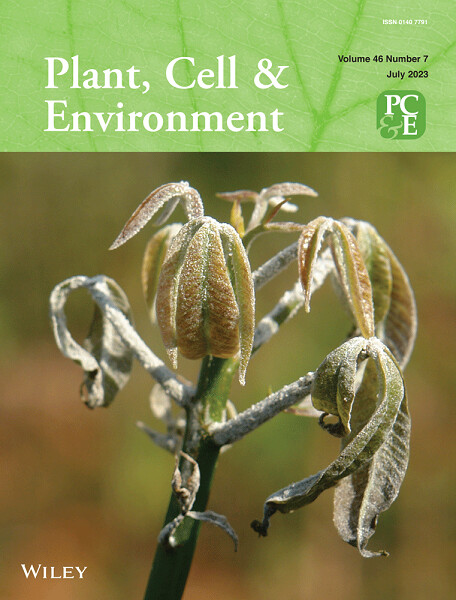
The cover image is based on the Original Article Single-cell transcriptomic analyses reveal cellular and molecular patterns of rubber tree response to early powdery mildew infection by Xiaoyu Liang et al., https://doi.org/10.1111/pce.14585.
Cover Image
- Page: ii
- First Published: 07 June 2023
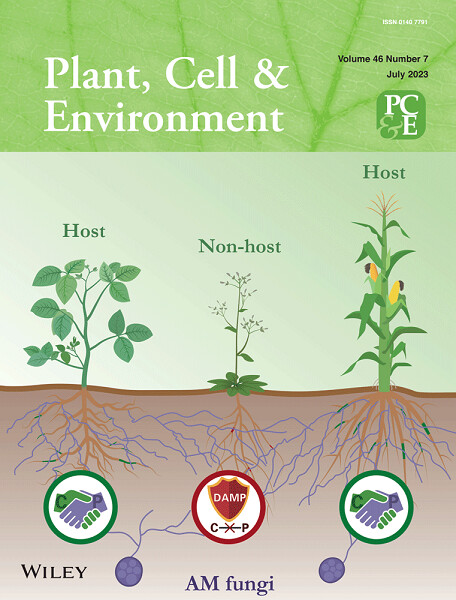
The cover image is based on the Original Article Arbuscular mycorrhizal fungi trigger danger-associated peptide signaling and inhibit carbon–phosphorus exchange with nonhost plants by Yutao Wang et al., https://doi.org/10.1111/pce.14600
ISSUE INFORMATION
REVIEW
The integration of reactive oxygen species (ROS) and calcium signalling in abiotic stress responses
- Pages: 1985-2006
- First Published: 02 May 2023
The systemic transmission of information from the environment, which is crucial to plant growth and resilience, involves interconnected waves of reactive oxygen species (ROS) and calcium (Ca2+) signals that transmit information from the point of origin throughout the plant to regulate growth, development and defence. This review considers the mechanisms and proteins that co-ordinate ROS and Ca2+ signalling processes to allow both synchronous and independent signalling in different cellular compartments. We consider the putative molecular switches that connect these the signalling pathways.
OPINION
Kin selection, kin recognition and kin discrimination in plants revisited: A claim for considering environmental and genetic variability
- Pages: 2007-2016
- First Published: 14 March 2023
We propose to add some aspects that are of great complementary importance to broaden the kin recognition, discrimination and selection framework in plants and that need to be considered in future studies.
ORIGINAL ARTICLES
Plant communication across different environmental contexts suggests a role for stomata in volatile perception
- Pages: 2017-2030
- First Published: 11 May 2023
This work indicates that environmental conditions impact the ability of Zea mays to detect volatile compounds and prime defense responses, lending support to the idea that plant stomata are involved in volatile uptake and perception.
Ghosts of dry seasons past: Legacy of severe drought enhances mangrove salinity tolerance through coordinated cellular osmotic and elastic adjustments
- Pages: 2031-2045
- First Published: 07 May 2023
Legacy of severe drought enhanced salinity tolerance in Aegiceras corniculatum and Rhizophora stylosa through coordinated adjustments in leaf turgor loss points and cell wall elasticity. Nevertheless, declining turgor safety margins may increase the vulnerability of mangroves to drought.
Deep-water uptake under drought improved due to locally increased root conductivity in maize, but not in faba bean
- Pages: 2046-2060
- First Published: 20 March 2023
Soil drying leads to a strong reduction of root conductance in shallow soil layers, which maize partly compensates by facilitating deep water uptake via local increases in root conductivity.
Pepper homeobox abscisic acid signalling-related transcription factor 1, CaHAT1, plays a positive role in drought response
- Pages: 2061-2077
- First Published: 02 May 2023
We previously reported that pepper SnRK2 type kinase CaSnRK2.6 functions as a positive modulator of abscisic acid (ABA) signalling and drought response. Building on this in the present study, we identified the homeodomain-leucine zipper class II protein CaHAT1 as a substrate of CaSnRK2.6, which plays a positive role in the regulation of drought stress response via ABA-mediated signalling.
GhbZIP30-GhCCCH17 module accelerates corm dormancy release by reducing endogenous ABA under cold storage in Gladiolus
- Pages: 2078-2096
- First Published: 02 May 2023
Sugars are regarded as integrators of environmental and endogenous signals. However, the relationship between abscisic acid (ABA) and sugars in the process of geophyte dormancy release is still unclear. In this study, we demonstrated that glucose plays a positive role in CDR in Gladiolus by decreasing endogenous ABA. We propose a GhbZIP30-GhCCCH17 module that mediates the antagonism between sugars and ABA during CDR by regulating ABA metabolic genes.
Chilling induces sugar and ABA accumulation that antagonistically signals for symplastic connection of dormant potato buds
- Pages: 2097-2111
- First Published: 08 May 2023
Endodormancy (ED) duration of potato tuber correlates better with soluble sugars accumulation (sugar units) than chilling units. Chilling induces sugar units and ABA accumulation, resulting in antagonistic signals for symplastic connection of the dormant bud, determining ED duration.
The SCL30a SR protein regulates ABA-dependent seed traits and germination under stress
- Pages: 2112-2127
- First Published: 25 April 2023
We found that an Arabidopsis SR protein represses ABA-induced gene expression to modulate seed traits and germination. Our results uncover a new player in ABA-mediated control of early plant development and stress responses.
Prolonged low temperature exposure de-sensitises ABA-induced stomatal closure in soybean, involving an ethylene-dependent process
- Pages: 2128-2141
- First Published: 17 April 2023
Prolonged chilling of soybean increased foliar ethylene evolution, abscisic acid concentrations and stomatal conductance resulting in extremely low leaf water contents. Applying the ethylene antagonist 1-MCP partially reversed this maladaptive stomatal response.
Anatomical drivers of stomatal conductance in sorghum lines with different leaf widths grown under different temperatures
- Pages: 2142-2158
- First Published: 17 April 2023
Coordination between leaf width and leaf anatomy underpins stomatal conductance variation in Sorghum bicolor lines grown under different temperatures.
Analysis of aquaporins in northern grasses reveal functional importance of Puccinellia nuttalliana PIP2;2 in salt tolerance
- Pages: 2159-2173
- First Published: 12 April 2023
Salt upregulated several PIP transcripts in the halophythic grass Puccinellia nuttalliana and enhanced the rate of water and sodium transport in yeast expressing PnuPIP2;2. Transport properties of PnuPIP2;2 may be affected by its unique pore characteristics, which include a combination of hourglass, cylindrical and increasing diameter conical entrance shape with pore hydropathy of −0.22.
Natural variation in salt-induced root growth phases and their contribution to root architecture plasticity
- Pages: 2174-2186
- First Published: 13 March 2023
By studying natural variation in salt-induced root growth phases in Arabidopsis, we show that main root growth rate during homoeostasis and lateral root appearance contribute most to root architecture and we reveal a trade-off between investing in main and lateral root growth during salt stress.
PHOSPHORUS-STARVATION TOLERANCE 1 (OsPSTOL1) is prevalent in upland rice and enhances root growth and hastens low phosphate signaling in wheat
- Pages: 2187-2205
- First Published: 22 March 2023
Might a rice gene that controls root plasticity confer a similar benefit in another grain crop? Here, we evaluate the genetic variation and evolutionary history of OsPSTOL1 and demonstrate its impact in wheat.
Arbuscular mycorrhizal fungi trigger danger-associated peptide signaling and inhibit carbon‒phosphorus exchange with nonhost plants
- Pages: 2206-2221
- First Published: 08 May 2023
There is no significant carbon and phosphorus exchange between AMF and colonized nonhost plant Arabidopsis thaliana. AMF activated the danger-associated peptide Pep-PEPR signaling pathway, which acted as a key participant in resistance to AMF colonization and in mediating growth suppression of nonhost plants.
Single-cell transcriptomic analyses reveal cellular and molecular patterns of rubber tree response to early powdery mildew infection
- Pages: 2222-2237
- First Published: 16 March 2023
We identified 10 cell types and constructed the first single-cell atlas of Hevea leaves. We found that the HbCNL2 gene, encoding a nucleotide-binding leucine-rich repeat protein, positively modulated the defence of rubber leaves against powdery mildew.
Utilising natural diversity of kinases to rationally engineer interactions with the angiosperm immune receptor ZAR1
- Pages: 2238-2254
- First Published: 09 May 2023
The angiosperm immune receptor ZAR1 displays specific interactions with diverse kinases, and rationally designed single amino acid substitutions in a kinase can affect interaction sensitivity.
Comparative proteomic and physiological analyses reveal tribenuron-methyl phytotoxicity and nontarget-site resistance mechanisms in Brassica napus
- Pages: 2255-2272
- First Published: 27 April 2023
We performed an integrated study of cytological, physiological, and proteomic analysis of the tribenuron-methyl resistant rapeseed mutant M342 and its wild-type N131. This study identified novel proteins with putative roles in non-target-site herbicide resistance in Brassica napus.





